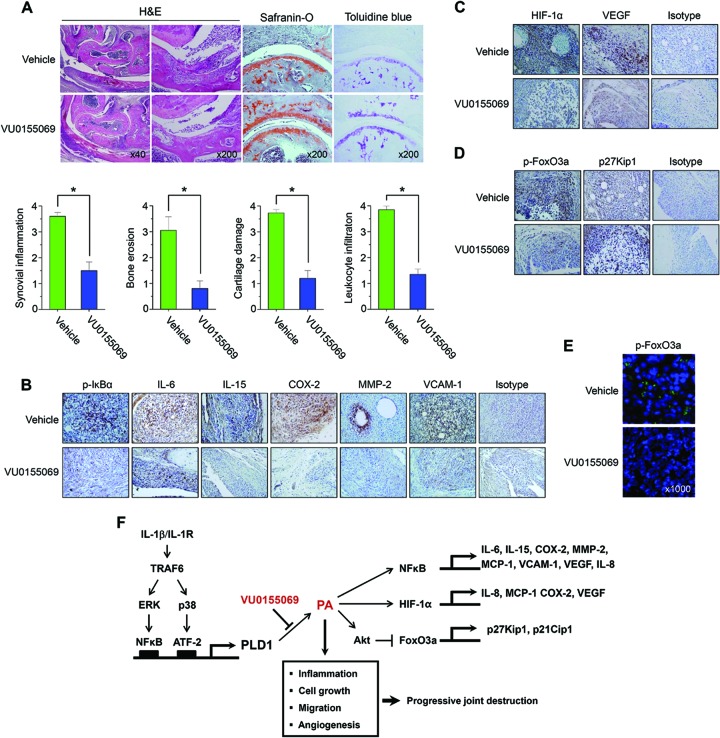Fig 7.
PLD1 inhibitor suppresses the pathogenesis of spontaneous arthritis, decreases the expression of NF-κB and HIF-1α target genes, and promotes the expression of FoxO3a target genes in IL-1Ra-deficient mice. (A) IL-1Ra−/− mice were treated with intraperitoneal injections of PLD1 inhibitor (10 mg/kg; n = 8) or vehicle (n = 8). Tissue sections from joints of each mouse were stained with H&E, toluidine blue, or safranin O. Representative photographs from each group are shown. The histological scores of mice treated with PLD1 inhibitor or vehicle are shown at the bottom. The data represent individual values and the average value of five individual mice in each group. *, P < 0.05 compared with the vehicle-treated group. (B to D) Tissue sections from the joints of mice treated with PLD1 inhibitor or vehicle were stained with the indicated Abs. The cells stained with each Ab are shown in brown (×400). (E) Tissue sections from the spleens of IL-1Ra-deficient mice were stained with 4′,6-diamidino-2-phenylindole (DAPI; blue) or anti-p-FoxO3a Ab (green). Tissues were monitored with a Zeiss LSM 510 confocal microscope. Anti-p-FoxO3a- and DAPI-stained images were overlaid to visualize the nuclear and cytoplasmic localization of p-FoxO3a. The data shown are representative of three independent experiments. (F) Model illustrating the roles of PLD1 in RAFLS. IL-1β binds to its receptor and stimulates the TRAF6-ERK/NF-κB and TRAF6/p38/ATF-2 signaling pathways, leading to selective PLD1 expression. PLD1-derived PA is involved in the production of proinflammatory mediators and angiogenic factors. PLD1 inhibitor abolishes the expression of molecules involved in RA pathogenesis by suppressing the binding of NF-κB/HIF-1α to the promoters of IL-1β target genes and enhances the expression of cell cycle arrest genes (p27Kip1 and p21Cip1 genes) via transactivation of FoxO3a. The abnormal upregulation of PLD1 in RAFLS may contribute to the pathogenesis of chronic arthritis and thus provide a potential target for the control of inflammatory arthritis.

